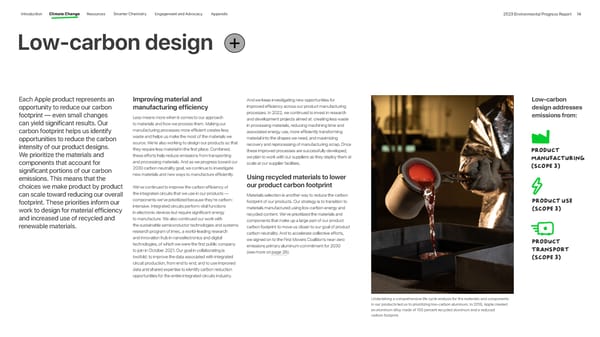Introduction Climate Change Resources Smarter Chemistry Engagement and Advocacy Appendix 2023 Environmental Progress Report 14 Low-carbon design Each Apple product represents an Improving material and And we keep investigating new opportunities for Low-carbon opportunity to reduce our carbon manufacturing efficiency improved efficiency across our product manufacturing design addresses footprint — even small changes processes. In 2022, we continued to invest in research emissions from: Less means more when it comes to our approach and development projects aimed at: creating less waste can yield significant results. Our to materials and how we process them. Making our in processing materials, reducing machining time and carbon footprint helps us identify manufacturing processes more efficient creates less associated energy use, more efficiently transforming opportunities to reduce the carbon waste and helps us make the most of the materials we material into the shapes we need, and maximizing intensity of our product designs. source. We’re also working to design our products so that recovery and reprocessing of manufacturing scrap. Once they require less material in the first place. Combined, these improved processes are successfully developed, Product We prioritize the materials and these efforts help reduce emissions from transporting we plan to work with our suppliers as they deploy them at manufacturing components that account for and processing materials. And as we progress toward our scale at our supplier facilities. (scope 3) significant portions of our carbon 2030 carbon neutrality goal, we continue to investigate emissions. This means that the new materials and new ways to manufacture efficiently. Using recycled materials to lower choices we make product by product We’ve continued to improve the carbon efficiency of our product carbon footprint can scale toward reducing our overall the integrated circuits that we use in our products — Materials selection is another way to reduce the carbon footprint. These priorities inform our components we’ve prioritized because they’re carbon- footprint of our products. Our strategy is to transition to Product use work to design for material efficiency intensive. Integrated circuits perform vital functions materials manufactured using low-carbon energy and (scope 3) in electronic devices but require significant energy recycled content. We’ve prioritized the materials and and increased use of recycled and to manufacture. We also continued our work with components that make up a large part of our product renewable materials. the sustainable semiconductor technologies and systems carbon footprint to move us closer to our goal of product research program of imec, a world-leading research carbon neutrality. And to accelerate collective efforts, and innovation hub in nanoelectronics and digital we signed on to the First Movers Coalition’s near-zero Product technologies, of which we were the first public company emissions primary aluminum commitment for 2030 to join in October 2021. Our goal in collaborating is (see more on page 26 ). transport twofold: to improve the data associated with integrated (scope 3) circuit production, from end to end, and to use improved data and shared expertise to identify carbon reduction opportunities for the entire integrated circuits industry. Undertaking a comprehensive life cycle analysis for the materials and components in our products led us to prioritizing low-carbon aluminum. In 2018, Apple created an aluminum alloy made of 100 percent recycled aluminum and a reduced carbon footprint.
 Apple Environmental | Immersive Page 13 Page 15
Apple Environmental | Immersive Page 13 Page 15